
Thelaziasis
[Thelazia spp.]
Causal Agents
Spirurid nematodes in the genus, Thelazia. Two species that have been implicated in human infection include T. callipaeda (the Oriental eye worm) and T. californiensis (the California eye worm).
Life Cycle
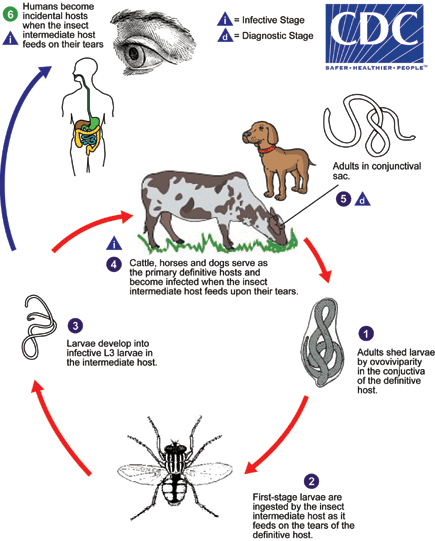
Dogs and other canids, cattle, and horses are the usual definitive hosts for Thelazia spp., although other mammals, including cats, lagomorphs, cervids and humans, can also become infected. Adults reside in the conjunctival sac of the definitive host  where they shed first-stage larvae
where they shed first-stage larvae  . These larvae are sheathed. The first-stage larvae are ingested by the intermediate host (usually flies, including drosophilid flies in the genus, Amioto, and muscid flies in the genera, Musca and Fannia), when they feed on tears and other lacrimal secretions
. These larvae are sheathed. The first-stage larvae are ingested by the intermediate host (usually flies, including drosophilid flies in the genus, Amioto, and muscid flies in the genera, Musca and Fannia), when they feed on tears and other lacrimal secretions  . In the digestive tract of the intermediate host, the larvae shed the sheath and invade various host tissues, including the hemocoel, fat body, testis and egg follicles where they develop in capsules. The encapsulated larvae become infective L3 larvae
. In the digestive tract of the intermediate host, the larvae shed the sheath and invade various host tissues, including the hemocoel, fat body, testis and egg follicles where they develop in capsules. The encapsulated larvae become infective L3 larvae  after two molts. Afterwards, the L3 larvae break out of the capsules and migrate to the fly’s mouthparts, where they remain until the fly feeds on the tears of the definitive host. The larvae invade the conjunctival sac of the definitive host and become adults after about a month and two additional molts
after two molts. Afterwards, the L3 larvae break out of the capsules and migrate to the fly’s mouthparts, where they remain until the fly feeds on the tears of the definitive host. The larvae invade the conjunctival sac of the definitive host and become adults after about a month and two additional molts  . Humans may also serve as a final host
. Humans may also serve as a final host  , after infected flies feed on tears or other lacrimal secretions.
, after infected flies feed on tears or other lacrimal secretions.
Geographic Distribution
Presumed worldwide; human infections have been recorded from the United States, China, Russia, India, Japan, and Thailand.
Clinical Presentation
Adults in the eye cause varying degrees of inflammation and lacrimation. In heavier infections, photophobia, edema, conjunctivitis, and blindness may occur.
Thelazia spp. adults.
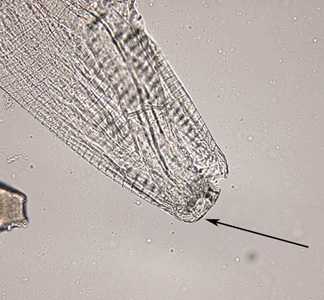
Figure A: Anterior end of a female Thelazia sp. Note the lack of lips (arrow) and prominent striations.
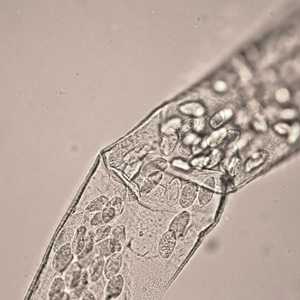
Figure B: Mid-section of a female Thelazia sp. Note the prominent striations.
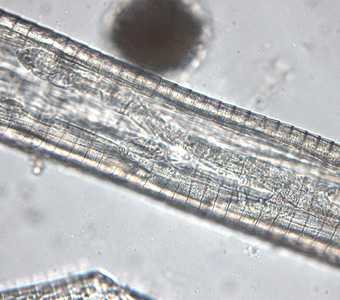
Figure C: Mid-section of a gravid female Thelazia sp., showing many typical spirurid-type eggs.

Figure D: Posterior end of a female Thelazia sp.
Intermediate hosts of Thelazia spp..

Figure A: Fannia canicularis, the lesser house fly. This species has been implicated in the transmission of thelaziasis in the United States and Asia. Image courtesy of Parasite and Diseases Image Library, Australia.External Web Site Icon
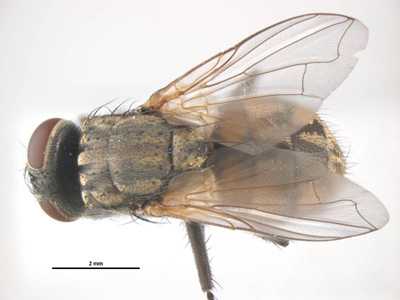
Figure B: Musca domestica, the house fly. This species has been implicated in the transmission of thelaziasis in the United States and Asia. Image courtesy of Parasite and Diseases Image Library, Australia.External Web Site Icon
Laboratory Diagnosis
Identification is made by the finding of adult worms in the conjunctival sac.
Treatment Information
Treatment is usually limited to the complete removal of the adult worms from the eye.
DPDx is an education resource designed for health professionals and laboratory scientists. For an overview including prevention and control visit www.cdc.gov/parasites/.
- Page last reviewed: September 25, 2017
- Page last updated: September 25, 2017
- Content source:
- Global Health – Division of Parasitic Diseases and Malaria
- Notice: Linking to a non-federal site does not constitute an endorsement by HHS, CDC or any of its employees of the sponsors or the information and products presented on the site.
- Maintained By:


 ShareCompartir
ShareCompartir